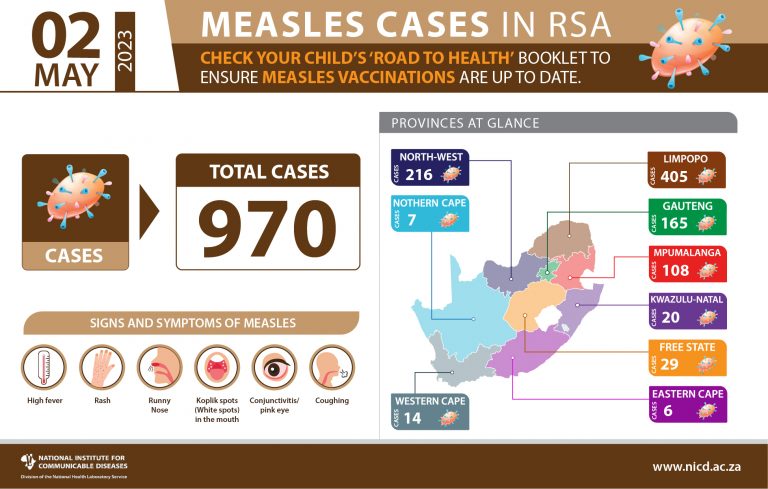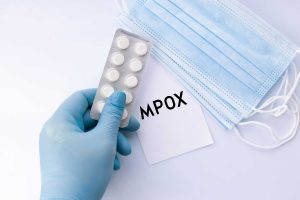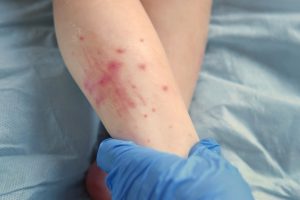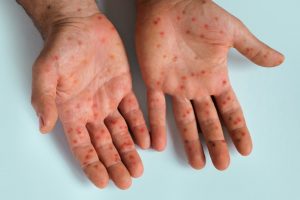Issued by the National Institute for Communicable Diseases based on laboratory testing data
Highlights
- The NICD has tested 5798 serum samples for measles since epidemiological week 40, 2022, of which 970 (17%) were confirmed positive. In outbreak-affected provinces, 964 cases have been reported since week 40, 2022. In the past weeks (week 15 up until week 16, 18/04/2023) there have been 20 laboratory-confirmed measles cases detected across the country, of which the majority were from Limpopo (12).
- The percentage of samples testing positive (PTP) increased from 20% of 99 samples tested in week 14 to 22% of 79 samples tested in week 15.
- Measles outbreak has been declared in all the provinces in South Africa except for the Eastern Cape. In week 16, no new cases were reported in Free State, KwaZulu-Natal, Mpumalanga, Western Cape, Northern Cape and North West provinces.
- The measles strain detected in Limpopo province and North West province is genotype D8 which is similar to the strain in Zimbabwe in the 2022 outbreak.
- In the provinces where an outbreak has been declared, the most affected age groups are still the 5-9-year-olds (43%) with a considerable proportion of cases reported among the 1-4 (24%) and 10-14 age groups (20%).
- Vaccination campaigns have so far included all children including those aged 10 to 14.
- The majority of cases (67%) were reported from primary healthcare facilities, and the highest proportion of cases reported from hospitals (59%) was reported in children under the age of one.
- Members of the public are urged to ensure their children are vaccinated against measles.
- Nationally, the reproduction number as of 2023-04-12 was estimated to be 0.65 (0.34 – 1.2), suggesting that infection incidence is likely decreasing. There is a 88% chance that the reproduction number was below 1 as of 2023-04-12.
- At the provincial level, the reproduction number as of 2023-04-12 was estimated to be 0.85 (0.54 – 1.2) in Limpopo, suggesting that infection incidence is likely decreasing. In contrast, the reproduction number as of 2023-04-12 was estimated to be 0.51 (0.27 – 0.85) in Mpumalanga, 0.67 (0.45 – 0.9) in Gauteng, and 0.49 (0.26 – 0.74) in North West, suggesting that infection incidence is decreasing.
- Note that the Easter holidays (2023-04-07 to 2023-04-10) occurred during the reporting period used to produce the latest reproduction number estimates. Declines in case reporting over the holidays may bias reproduction number estimates and resulting forecasts downward. Because the methods employed depend on reported case numbers, as detection returns to baseline levels over the coming 1-2 weeks, this may result in the appearance of a resurgence in the transmission that is an artefact of the holiday period. During this time, it is especially important to monitor other indicators, such as the percentage testing positive, for consistency with reproduction number estimates when interpreting trends.
Outbreak overview
From epidemiological week 40, 2022 (ending 8 October 2022) to week 16, 2023 the NICD has tested 5798 serum samples for measles of which 970 (17%) were confirmed measles cases. The number of samples submitted and the percentage of laboratory-confirmed measles-positive cases are shown in Figure 1. From epidemiological week 40 of 2022 to week 16 of 2023, 964 laboratory-confirmed cases were reported from eight provinces with declared measles outbreaks; Limpopo (405 cases), Mpumalanga (108 cases), North West (216 cases), Gauteng (165 cases), Free State (29 cases), Western Cape (14), KwaZulu-Natal (20) and Northern Cape (7) (Table 1). The geographical distribution of cases across South Africa from week 40 of 2022 until week 16 of 2023 is shown in Figure 2The number of blood samples and throat swabs submitted to the NICD for measles serology and PCR testing has decreased from 99 in week 14 compared to 79 in week 15 (Figure 3).
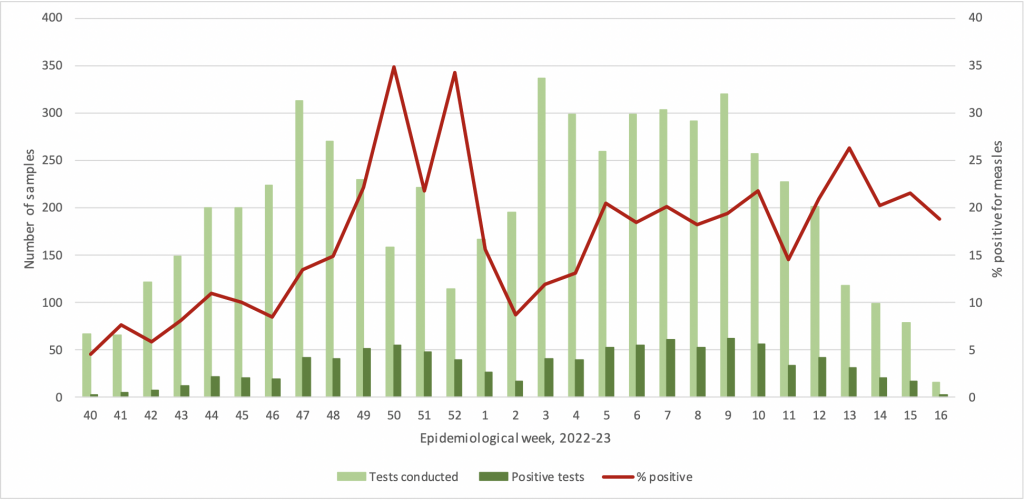
Figure 1. Number of serum samples submitted to the NICD for measles, week 40 2022, until week 16, 2023, and the number (dark green) and % tested positive (red line), by epidemiological week using the date the specimen was collected. *Data from week 16 represent partial data, and will be updated in next week’s situation report, when complete data from samples collected that week becomes available.
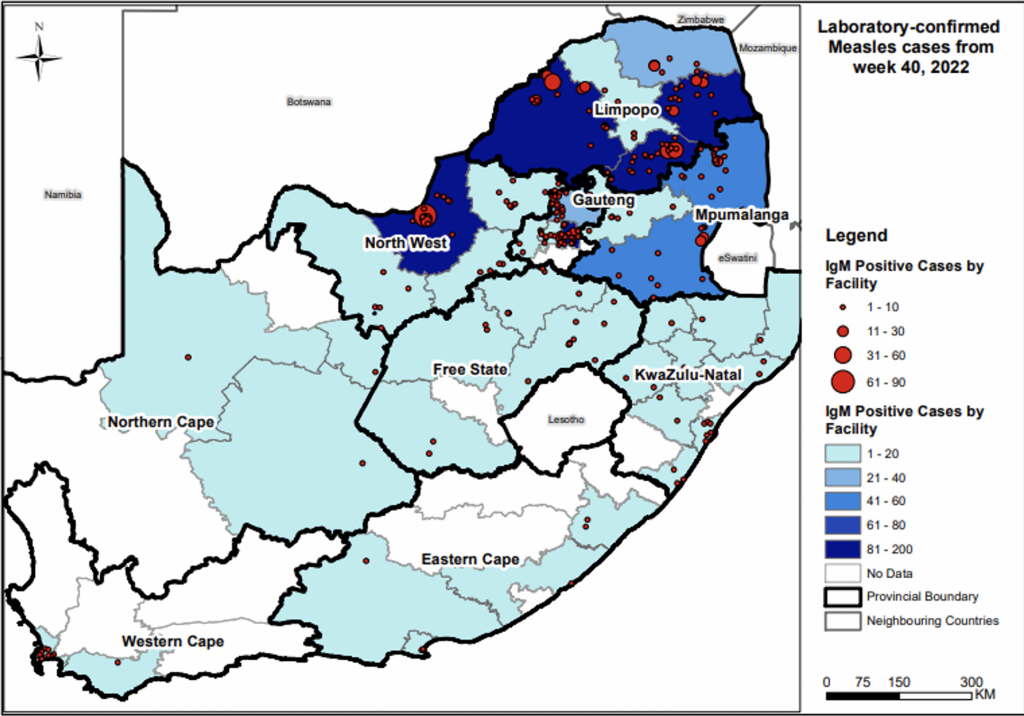
Figure 2. Distribution of laboratory-confirmed measles cases by testing site (red dots – the size of the dot indicates the number of cases from that facility) and district of South Africa (deepening colour of blue indicates the total number of cases by sub-district), from week 40 to week 16, 2023.
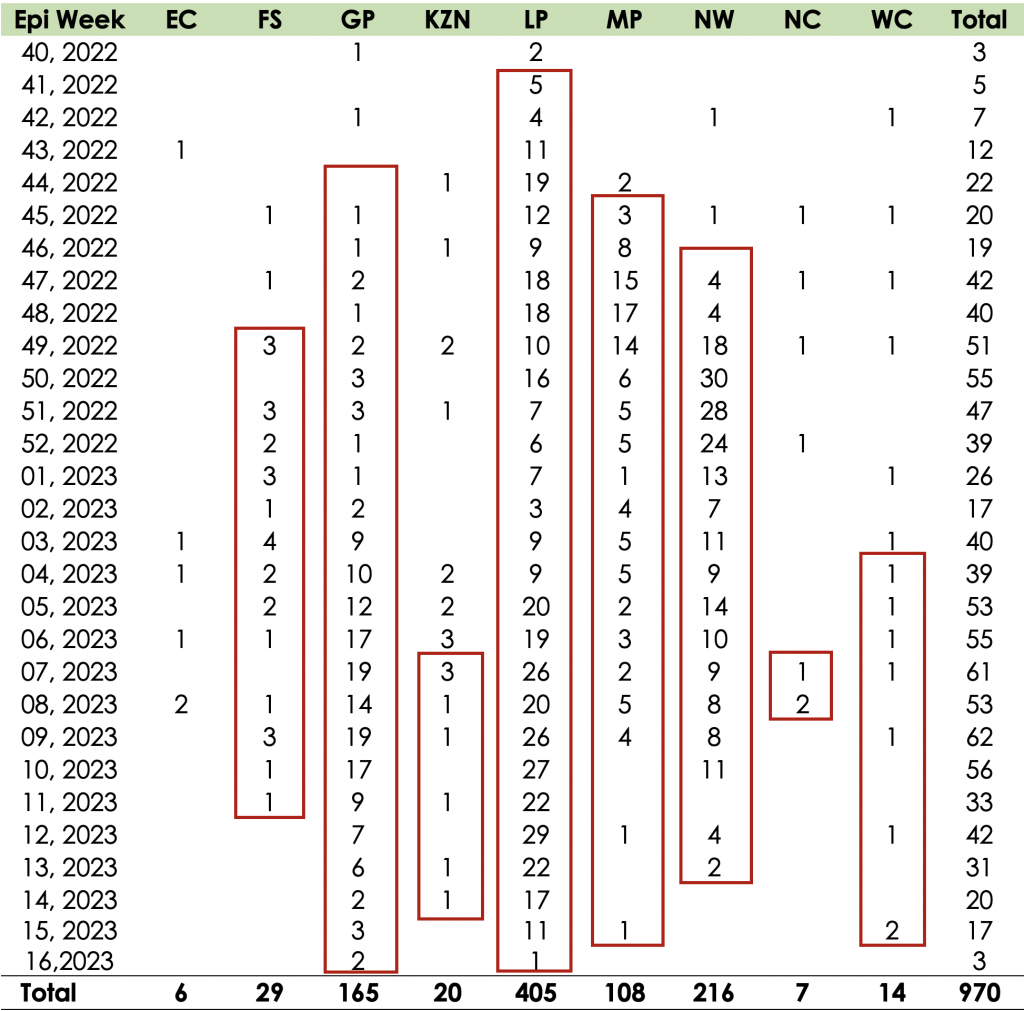
Table 1. Cases of laboratory-confirmed measles tested by the NICD from all provinces in South Africa from epidemiological week 40, 2022 to week 16, 2023. Outbreak-associated cases are contained within the red bordered cells* (FS=Free State; GP=Gauteng; KZN=KwaZulu-Natal; LP=Limpopo; MP=Mpumalanga NW=North West; NC=Northern Cape, WC = Western Cape). * A measles outbreak is classified as three or more confirmed laboratory measles cases reported within 30 days of onset of disease, in a district. *Data from week 16 represents partial data, and will be updated in next week’s situation report, when complete data from samples collected that week becomes available.

